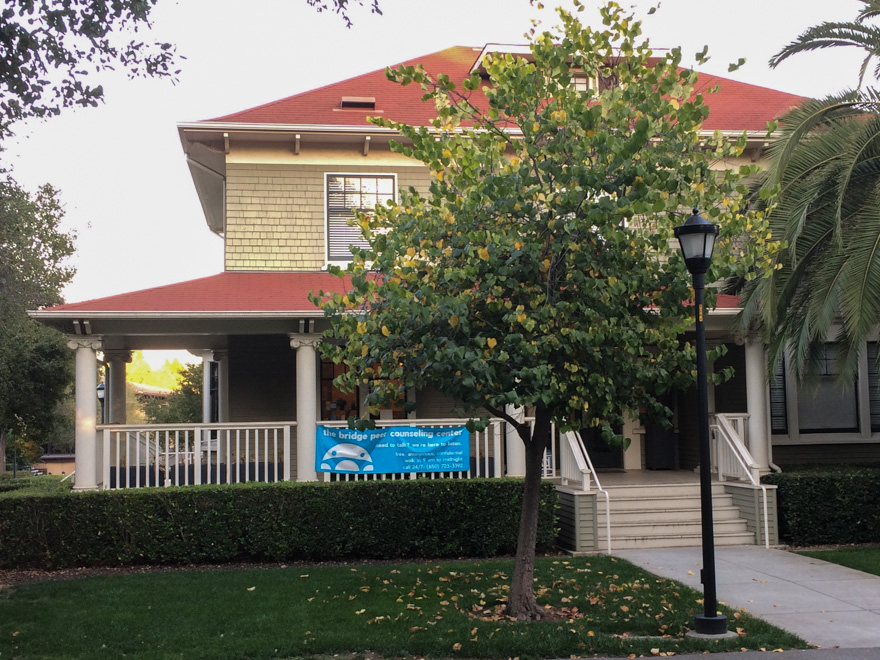The Bridge Peer Counseling Center, known colloquially as “the Bridge,” is facing a shortage of student counselors. Bridge staff members are working to improve the organization’s attraction and retention of counselors through increased advertising and community building.
The student-volunteer-run peer counseling center, open 24/7, is a mental health resource dedicated to providing free and confidential support to students. The Bridge operates out of the Rogers House on Capistrano Way.
According to Bridge live-in counselor Devon Burger ’19, the counseling center has typically had an excess of counselors willing to take shifts, but turnout has dropped off in the 2018-2019 academic year.
“We had a few shifts that were open at the beginning of the quarter,” Burger said.
Amanda Spyropoulos ’19, another live-in member, said the number of counselors at the Bridge for the start of each quarter has typically hovered in the thirties, but the number was sixteen this year.
In an effort to help mitigate its staff shortage, the Bridge has been reaching out to past counselors to take open shifts. Current members have been supplementing the shortage, with live-in counselors taking on a large share of the hours.
“We sort of reached out to [past] counselors and were like, ‘Hey! Do you want to take some [shifts]?’ And a lot of people did,” Burger said.
By week two, the Bridge had 31 staffers signed up.
Spyropoulos linked possible staff shortages to insufficient advertising or knowledge of the Bridge, especially during the first few weeks of New Student Orientation (NSO), during which there is a large number of club sign-ups.
“We had an open house at the Bridge during NSO,” Spyropoulos said. “Only about 10 people showed up.”
According to Burger, the absence of 2018 graduates from the Bridge community may have contributed to the staffing shortage.
“We had a lot of seniors graduate,” Burger said. “And then, because it’s fall quarter, freshmen aren’t eligible to start staffing yet … It definitely limits who is available to staff.”
In order to become eligible to serve at the Bridge, students must pass a two-unit course and a mock-counsel exam.
“We hold our counselors to an incredibly high standard,” Burger said. “There are quarters where [the mock-counsel exam passing rate is] 30 percent, others where it is 50 [percent] … It’s generally on the lower end.”
Despite the requirements necessary to become a Bridge counselor, both Burger and Spyropoulos said that the difficult path is by no means a deterrent to most individuals hoping to join the organization.
“I’m not sure how much is [even] known about what percentage gets selected,” Burger said.
Other members of the Bridge hypothesized that the decreased retention rate of counselors may be attributed to a shift in the ambience and general feel of the organization over the years.
One graduating class included only two Bridge counselors, despite 15 of the class members having joined the Bridge in their sophomore year.
Vickie Wang ’19 explained that, a few years ago, the Bridge community was more tight-knit. Rogers House was seen not just as a workspace but as a social space. According to Wang, a shift in the club’s atmosphere may have influenced the staff shortage to some extent.
Bridge members discussed possible strategies to increase the community aspect of the Bridge in a meeting on Monday, Oct. 15. Suggestions included transforming the Rogers House into a more social space, providing free printing for counselors, redecorating the house and providing food for staffers during their shifts.
The Bridge’s main strategy for recruiting new members consists of attending dorm meetings throughout campus and discussing the Bridge’s work, prior to the opening of registration for the prerequisite counseling class. According to Wang, once someone joins the Bridge, a love and appreciation for the nature of the work may encourage them to stay on staff.
Despite the staffing shortage, Burger emphasized that counselors want to assure students that the Bridge and its services are here to stay.
“It’s not ideal, but we’re making it work,” Burger said. “No one should be worried about the Bridge’s longevity on campus – we will be here. We’ve been here for a long time, and we will continue to be here for a long time.”
Contact Valerie Trapp at trappv22 ‘at’ stanford.edu.
